In August, after the landslides at the Rest and Be Thankful, I visited Glen Falloch to look at what damage had been done to the run of river hydro schemes there by the heavy rainfall. It is three weeks since I blogged about the damage that I had missed seeing in 2019 (see here). That was caused when the River Falloch was just 30cms higher and prompted a series of posts a year ago on the flood damage (sees here, here, here and here). While not as dramatic as 2019, the impact that flooding has had on the hydro schemes on the south side of the glen over the last year has nevertheless been extremely significant. This post will consider what has happened to the seven intakes and argue that this raises serious questions about their design, impact and sustainability.
Intake 1 – Upper Glen Falloch

Although the Upper Glen Falloch hydro is the smallest of the four Glen Falloch hydro schemes in terms of power generated (1 MW), it had the largest single intake by area. Many walkers will have passed by it from the large layby on the A82 south of Crianlarich on the way to An Caisteal, Beinn a Chroin or Cruach Ardrain. It was conceived of as a large pool.
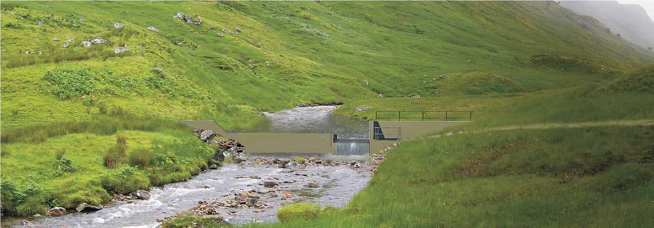
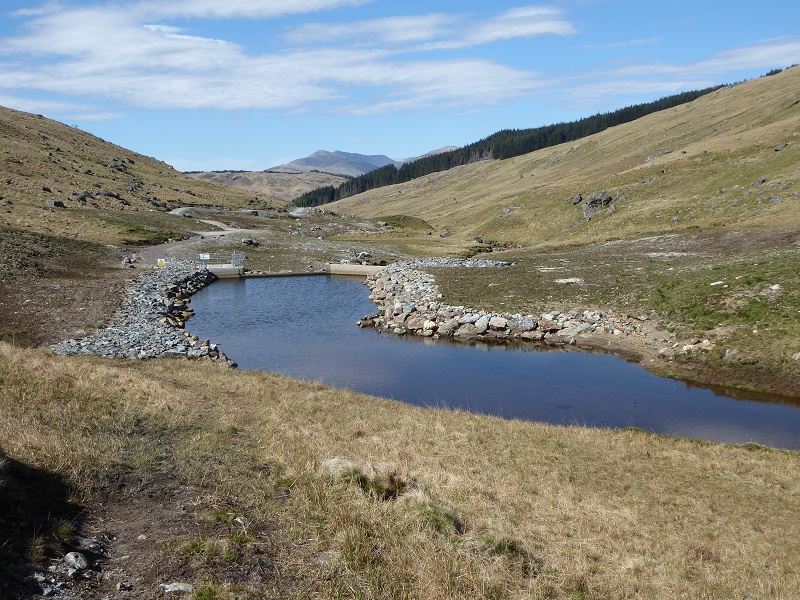
In September 2019, the pool was still there, despite the serious floods the previous month but with signs of additional infilling:
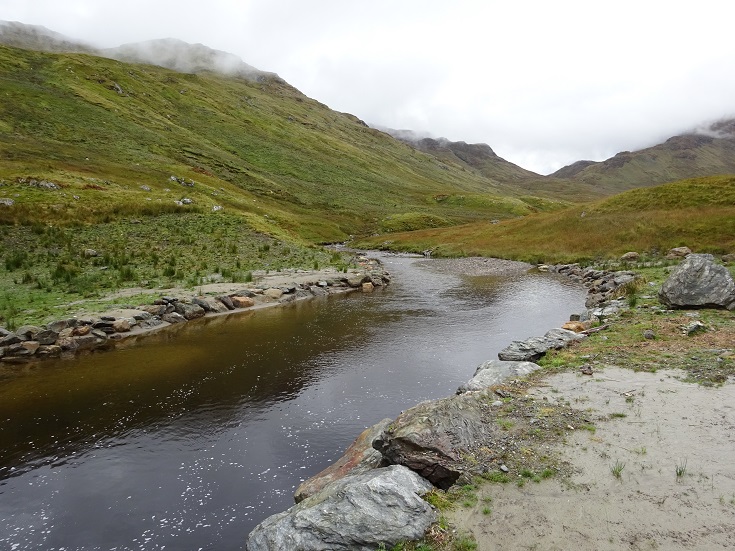
In the year since, the pool has almost completely infilled:
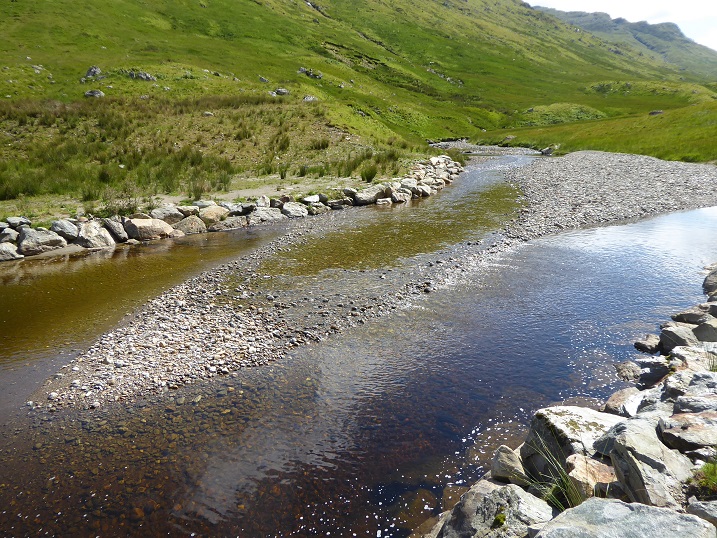
The shingle has softened the intake pool with its rip rap bouldering. That is out of place in a once wild glen but then nature generally tends to look far better than crude engineering.
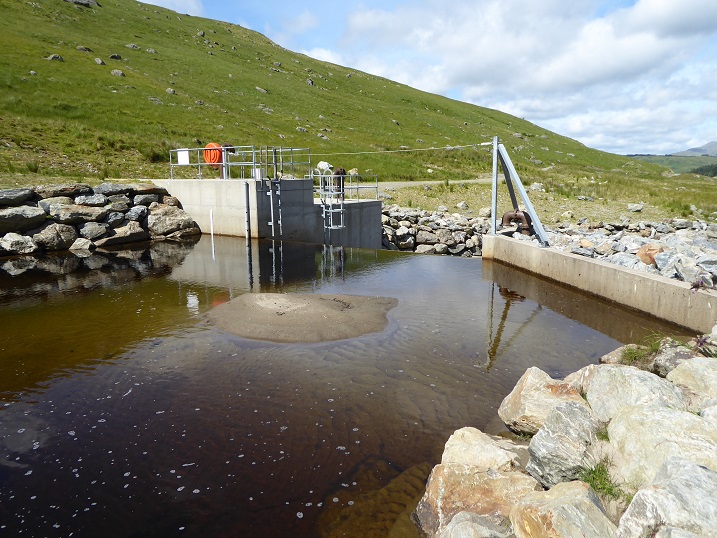
The intake structure remains for now but it has trapped a large volume of material which now threatens its viability. There are two aspects to this. The first is if the pool infills much further the River Falloch could change its course leaving the hydro intake high and dry, as it almost did in August 2018 (see here):
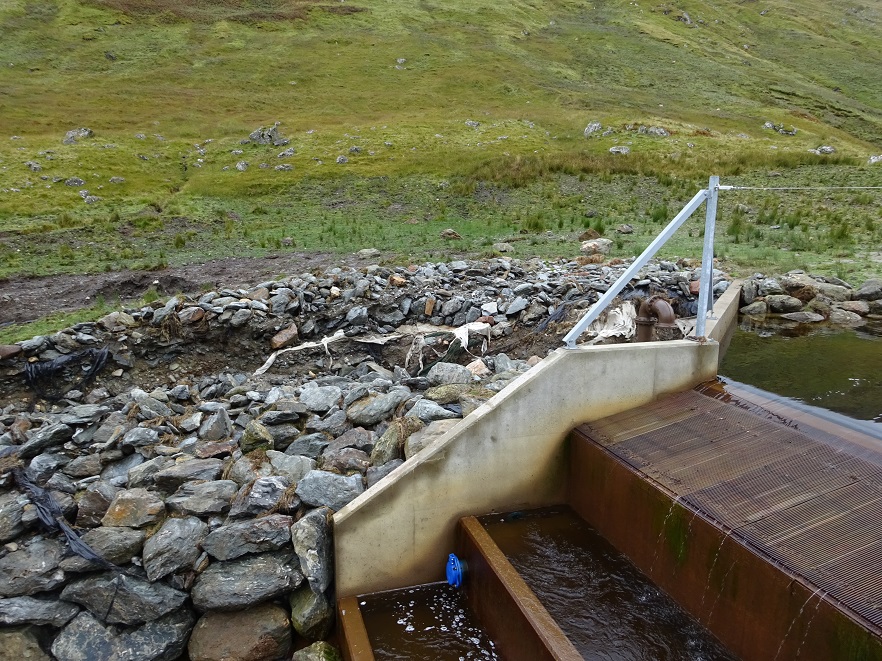
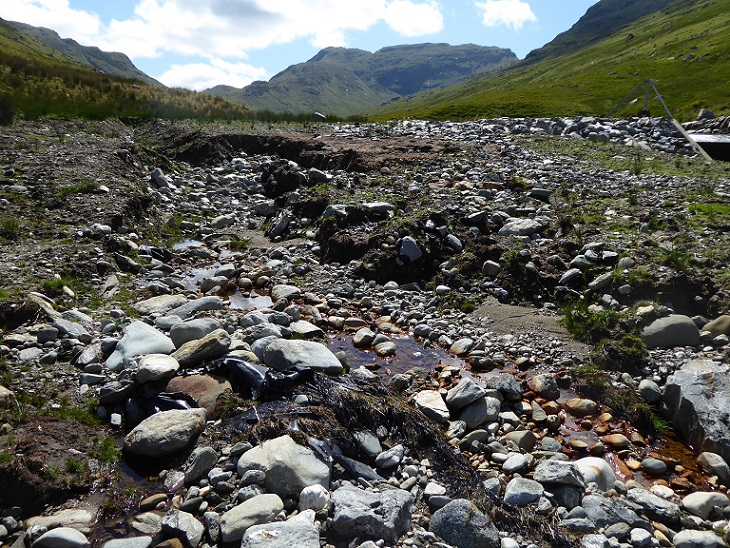
Leave aside the very poor attempt at restoration, with plastic everywhere and large amounts of peat just waiting to be swept away – poorly situated hydro schemes like this release significant amounts of carbon into the atmosphere – the potential for the river to change course is obvious. For this hydro to remain viable constant engineering will be required.
The operators didn’t submit a new planning application to explain how they were proposing to address these design flaws. Perhaps Loch Lomond and Trossachs National Park Authority LLTNPA staff advised them not to? Whatever the explanation, the LLTNPA has opened the door to an engineering free-for-all to enable this hydro to remain functional.
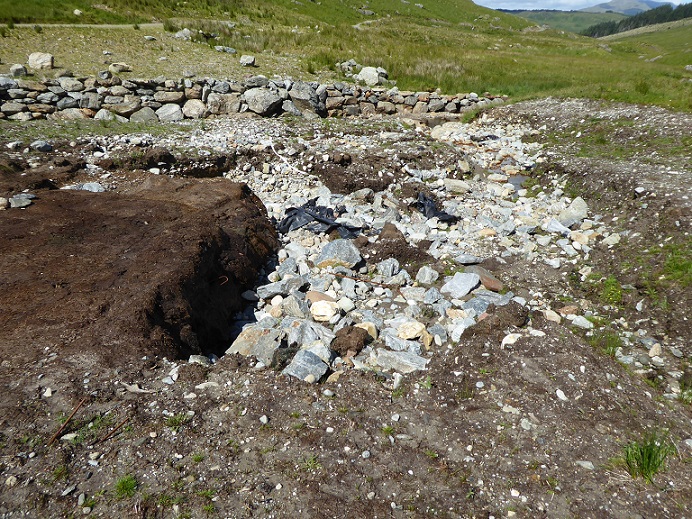
The second reason why infilling matters is that our so-called run of river hydro schemes are not actually run of river at all but all depend on intake pools. These helps reduce the sediment or small rocks being fed through the hydro pipes and prevent constant damage to the intake screens from large boulders being carried over them. If the pools fill up, the hydro scheme risks being seriously damaged. Hence the need for constant civil re-engineering, a requirement associated with these schemes which has, to date, been swept under the carpet.
Intake 2 – Allt Andoran

On the other side of An Caisteal’s north ridge lies the Allt Andoran intake. It also suffered serious damage large year with some of the rip rap bouldering below the intake swept away (again, see here).
A year ago there was a pile of boulders that had been excavated from the pool to get the hydro functioning again:
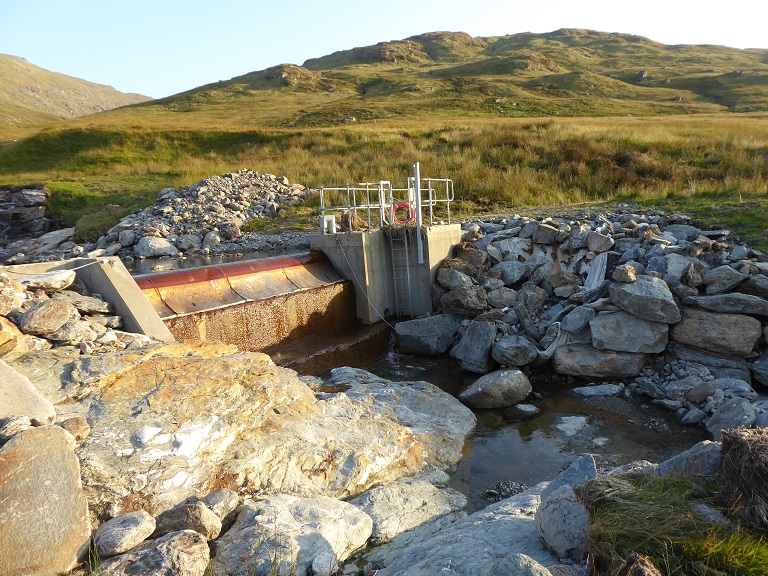
Now, there is an enormous pile of boulders:
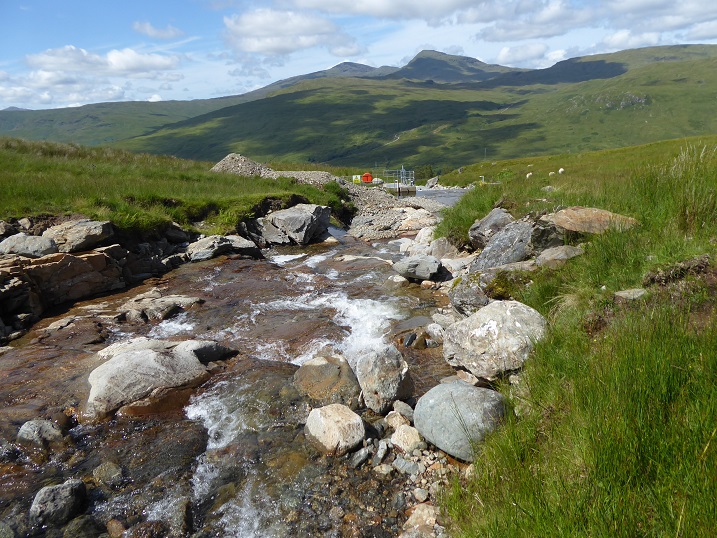
We now have river mining in what is supposed to be a National Park. It has not had planning permission. I have not yet found out whether the Scottish Environment Protection Agency has approved the work – most extraction from rivers requires a license under the Controlled Activities Regulations.
Both SEPA and the LLTNPA should also be concerned about how the extraction of all this material affects the ecology of the river below. Shingle and sand provides a home for wildlife but, if it going to be extracted and dumped like this, it can’t do that anymore. That will have a knock on effect on fish and birds like dipper and grey wagtail.

The intake itself has become increasingly battered and damaged, illustrating why continual excavation of this pool will be necessary. The narrow mesh Coanda screens are very good at keeping potentially damaging stones and vegetation out of the hydro system but are themselves very vulnerable to damage by boulders and pebbles rolling over them. There are sturdier intake screens, but they let more material into the hydro system, potentially damaging the pipes and turbines.
Intakes 3, 4 and 5 – the Allt Chuilinn
The Allt Chuilinn flows down the next glen to the west and is fed by three intakes. It had suffered the most spectacular damage last year but the smallest intake had been out of commission before that. Poor design and construction had resulted in the burn flowing under the intake leaving what should have been the intake pool high and dry. It has now been fixed:
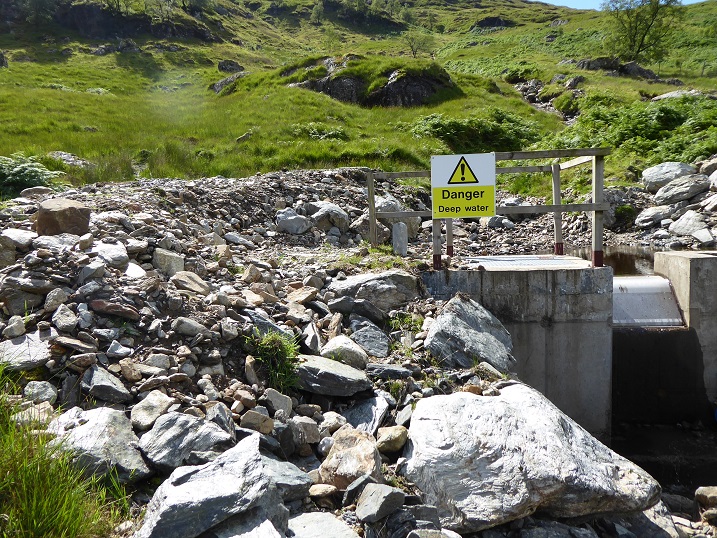
To give Glen Falloch estate credit, a large amount of re-engineering has been undertaken without a new track being put in place and there was very little sign of vehicle damage to the vegetation below. However, the location of this intake means the burn constantly risks changing course, hence the bulldozed bank on the left intended to keep it in its course. Whether that will be enough is not clear. There are signs that this burn might change course higher up.
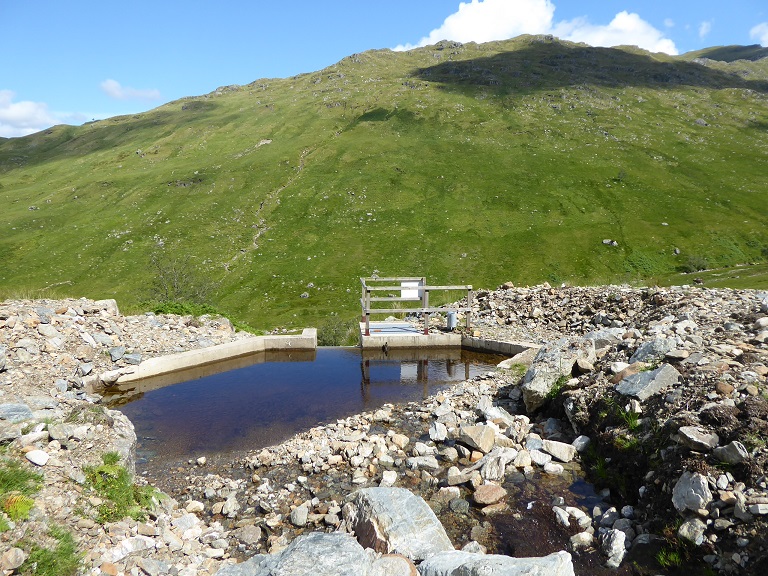
Again, none of this work has had planning permission. Although hardly visible from the constructed hydro track below, the local landscape impact is significant. It is like coming across one of those mine spoil heaps that litter the Lake District that have taken over a century to mellow.
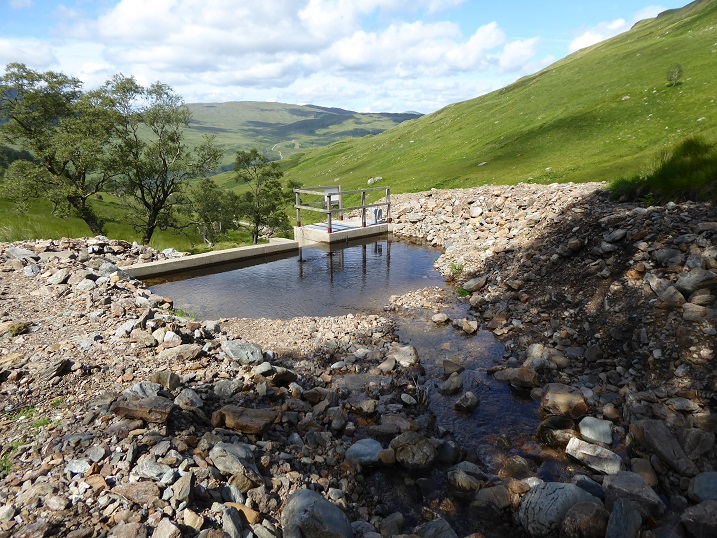
There were large rocks around the middle intake in 2018 but they have now been covered with smaller rocks excavated from the river. The pool is not big and, as you can see, is at constant risk of infilling. As soon as debris piles up behind the small intake the burn will divert over the intake wall taking the scheme out of commission. A reasonable guess is it may need to be excavated every couple of years to keep it functional given current levels of rainfall and erosion.
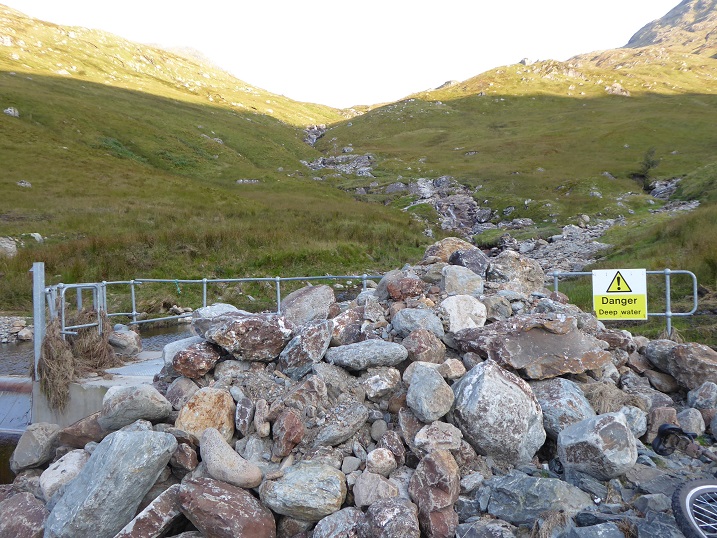
The main intake of the Allt Chuilinn was where the worst damage was caused a year ago, with the pool apparently infilled and the rip-rap bouldering along the bank below swept away revealing the hydro pipe.
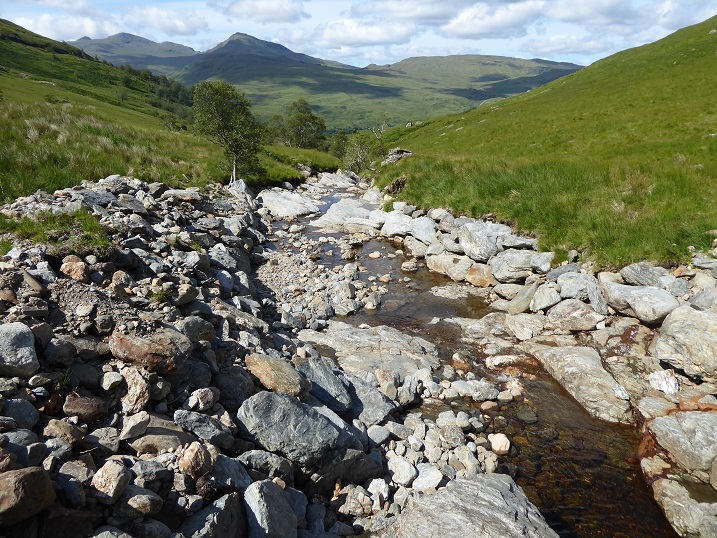
The restoration, which has again taken place outwith formal planning processes, has again been crude with boulders dumped over the bare pipe. It appears to me that if similar floods to those that occurred in August 2019 were to re-occur much of the “new” left bank would wash away. Both the LLTNPA and SEPA should be concerned about this and involved in trying to find solutions. Unfortunately, instead of admitting to mistakes and addressing the issues, the LLTNPA would prefer to pretend nothing has happened. The convener of the National Park, James Stuart, told me a year ago there is no need for any inquiry into the impact of the flooding on these hydro schemes. In my view he has got this badly wrong.
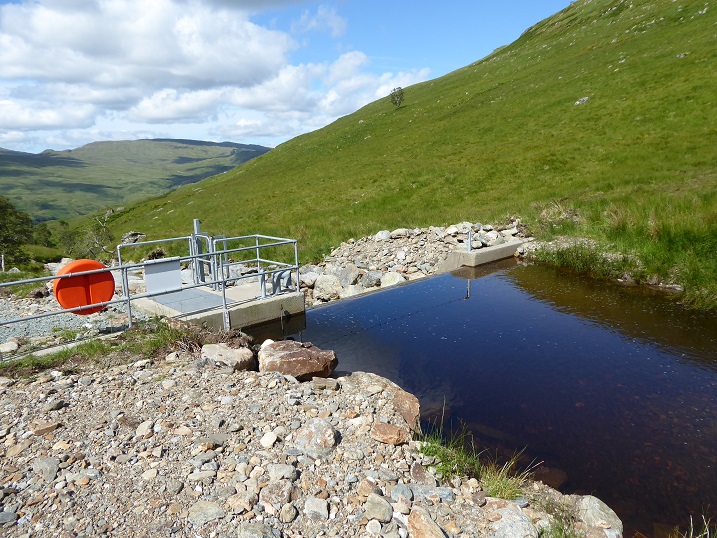
A year after being excavated, the main Allt Chuilinn intake pool is still functioning but for how long? If you look carefully you can see how the pool is again gradually infilling. That is nature, you cannot stop these processes, though overgrazing on the hill and increased extreme rain events caused by climate change have increased the rate at which they take place. That has significant implications for the viability of run of river hydro schemes across Scotland.
Intakes 6 and 7 – on the Ben Glas hydro scheme
On the other side of the exquisitely bumpy ridge connecting Beinn Chabhair and Ben Glas are the two intakes of the Ben Glas hydro scheme.
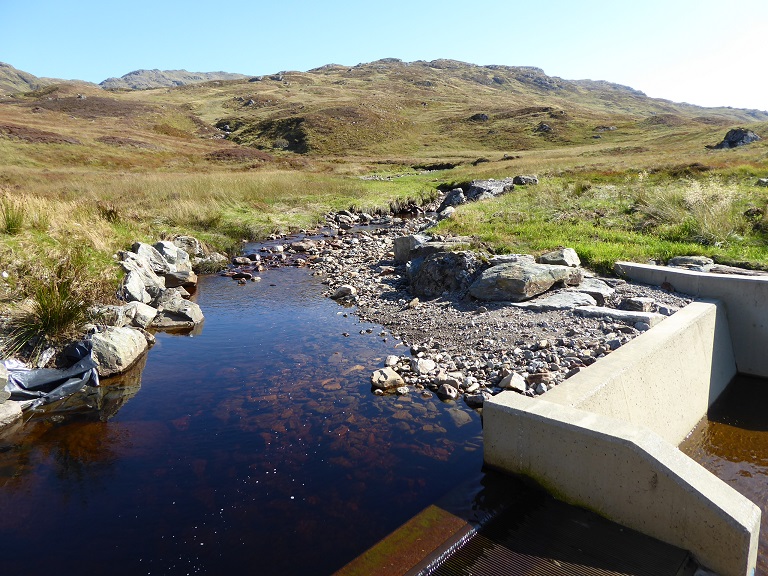
Last year these had been the least affected of all the hydro intakes on the south side of Glen Falloch. Various bits of damage had been done, however, to the higher of the two intakes and it had started to infill.
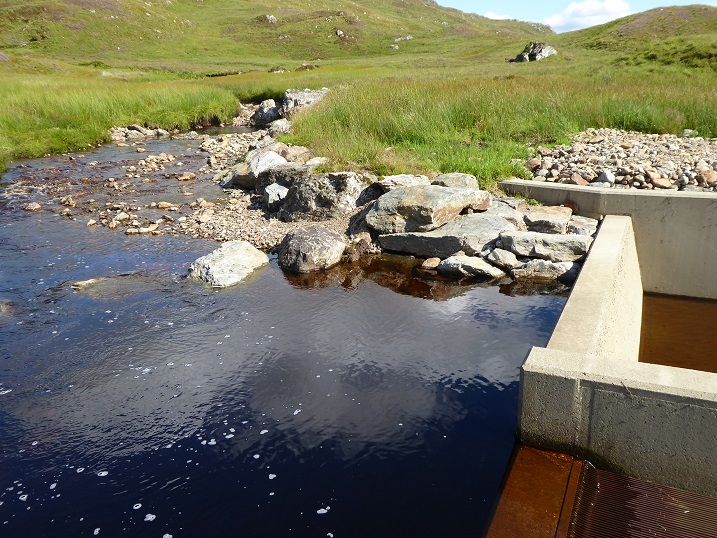
This intake has also now been escavated. Judging by the amount of material evident on the bed of the burn above, fairly frequent engineering is likely to be required to keep this scheme going too.
The only intake that appeared unaffected by flood damage and infilling was the last I visited:
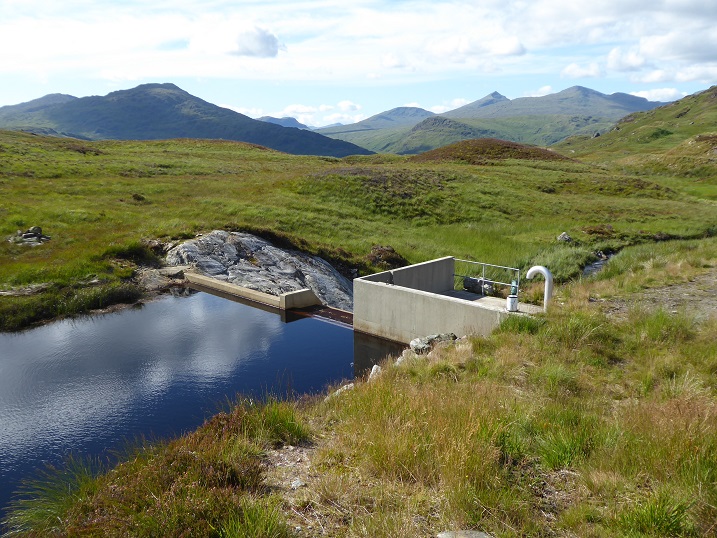
There are reasons for this. The intake is built into a slab of rock which is far more resistant to flood damage than rip-rap bouldering. Spate water just flows over it while on the near side is a moraine bank. This is a burn that is unlikely to change course in the near future.
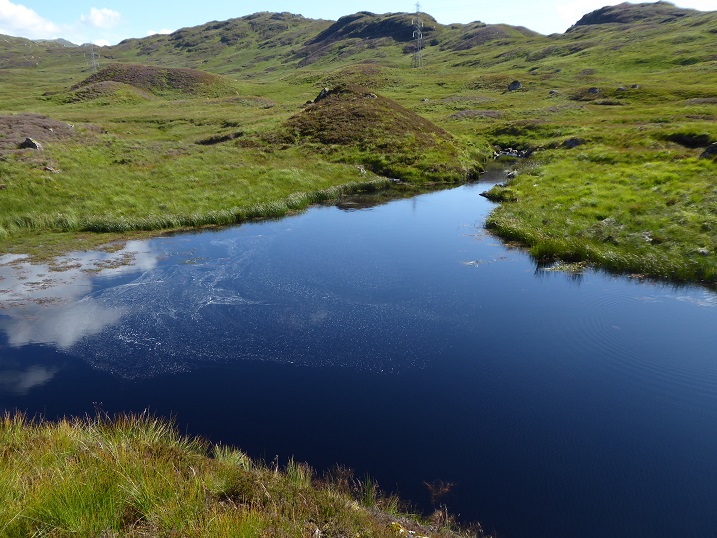
Like the Upper Falloch there is a large pool, but this one looks good – almost natural – and isn’t infilling. The reasons for this relate to the topography. The burn feeding the pool is not steep and fast flowing but instead wends it way through peat bog. The peat and the vegetation reduce the sediment and rocks that can enter the river system, while the gentle angle means that any material that does enter the burn moves along slowly. Assuming the intake wall has been well constructed, there is unlikely to be any need for further engineering here any time soon, a contrast to the other six intakes on the south side of Glen Falloch. It appears therefore to be the only intake out of the seven that has been well designed and located.
That doesn’t mean that it has had no impact. The intakes here have reduced the flow of water over the Eagle Falls, affecting its scenic beauty, and even this intake will have some ecological impacts by reducing the amount of sediment and vegetation carried downsteam. But it far better than the rest and the only one that is unlikely to require constant re-engineering. You could say it is the only one that is remotely sustainable.
What needs to happen
The damage to the Glen Falloch hydro schemes and the infilling of their intakes should prompt a national re-think of run of river hydro schemes. Small-scale hydro has been heavily promoted by naive environmentalists and developers on the make as an answer to climate change. Almost no consideration has been given to their adverse impacts or sustainability. Despite the heaps of paper generated by consultants in developing the planning applications for these schemes, I have read not one that predicted these issues. The people who have real expertise in hydrology, landscaping and river ecology appear to have been sidelined and silenced by the gold-rush.
The question of sustainable intakes is just one of the hydro issues that needs to be considered and tackled nationally if the Scottish Highlands is not going to be littered by abandoned hydro schemes in twenty years time, once the extremely lucrative Feed In Tariff subsidies run out. Until then landowners and developers will bear the repair costs, though whether they undertake those repairs to a high standard is a problem in the making.
The key issues that need to be addressed are:
- The location of hydro intakes. The evidence in this post suggests that locating hydro schemes on flashy west of Scotland rivers, as most have been, is fraught with difficulties. Hydro intake are better located on gentle burns where there is a large drop below. They need to be located on flat ground over the brow of the hill with plenty of space behind to absorb sediment, not on the steep sides of glacially excavated glens. The hydro intakes in Glen Etive – about which more soon – are a disaster waiting to happen.
- Whether existing schemes on flashy rivers can be redesigned to make them more sustainable. The evidence from Glen Falloch is not promising.
- How to mitigate the impacts of constant re-engineering. The planning system should have a key role in making this happen. It will come as no surprise to regular readers that the evidence from Glen Falloch suggests the LLTNPA has abandoned the field and its responsibilities as a planning authority.
- And finally, where hydro schemes cannot be repaired without unacceptable impacts, what needs to be done to remove them.
Unfortunately, instead of giving a lead on these issues, as National Parks should be doing, the LLTNPA is part of the problem. I wish I had a solution but I am certain now the LLTNPA is not part of it. As I suggested in my post last week on the LLTNPA’s failure to enforce basic restoration requirements at the Ballimore hydro (see here), if you see something that looks bad, please complain or if in doubt please send your photos to Nickkempe@parkswatchscotland.co.uk
Postscript – evidence from the Alps
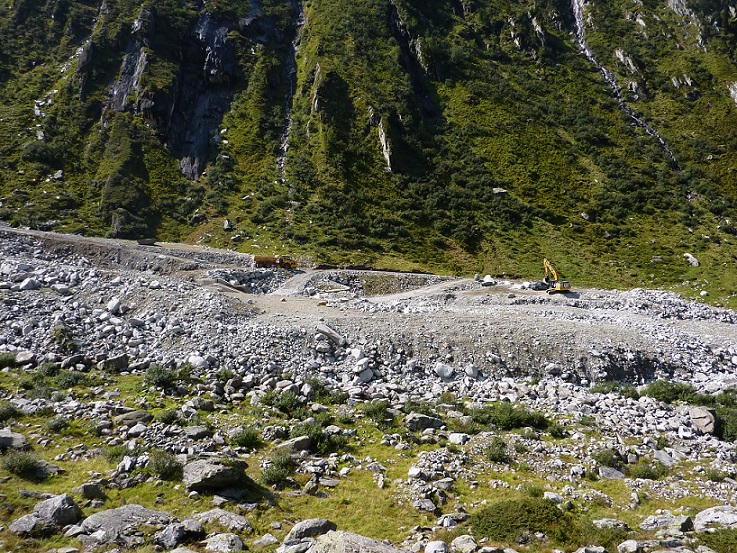
A reader yesterday – see comments – mentioned that infilling and subsequent excavation of intakes was a longstanding issue from older hydro schemes in Scotland and also in the Alps. Little consideration appears to have been given to the historical evidence in deciding where to locate run of hydro schemes.
Good write up Nick. One has to ask whether the system for compensation flow is being maintained during all this chaos and is it being policed by anyone. I was in Etive last week it’s really difficult to see how the schemes on the south side of the Glen can be implemented given what’s happening here.
Damage from catastrophic rain events seems increasingly predictable. Some form of planning mechanism is required. Compelling scheme operators to post an infrastructure restoration bond or some kind of ring fenced sinking fund, held by a third party, should schemes delivering genuine sustainable power become damaged or inoperative for a period. We don’t want to get to a situation, similar to open cast mining, where huge restoration costs fell on the tax payer when an operator ceased trading and bonds were inadequate. Its not a new problem. Many of the earlier (1950/60s) hydro scheme intakes have large boulder piles beside them , Cuaich, Dalwhinnie and the Upper Garry (you can see from the train) for example. It’s also not just a Scottish mountain problem. I wanted to post a picture of a hydro intake and large excavators looking small amid a massive dump of boulders and debris in an Austrian alpine NP – a sight I’ve seen in several other locations.
One of Duncan’s photos is not appended to the post as a postscript – an even more dramatic illustration of the issues
Is this just poor engineerin?. How do these recent intakes compare with the various intakes for the Sloy scheme in the 50s. For example I’m not aware of problems with the intake just above the trees on the tourist path up the Cobbler. But then I can’t say I have paid it that much attention. Just a feature that was always there.